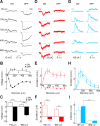Morphology and function of three VIP-expressing amacrine cell types in the mouse retina
- PMID: 26311183
- PMCID: PMC4620131
- DOI: 10.1152/jn.00526.2015
Morphology and function of three VIP-expressing amacrine cell types in the mouse retina
Abstract
Amacrine cells (ACs) are the most diverse class of neurons in the retina. The variety of signals provided by ACs allows the retina to encode a wide range of visual features. Of the 30-50 AC types in mammalian species, few have been studied in detail. Here, we combine genetic and viral strategies to identify and to characterize morphologically three vasoactive intestinal polypeptide-expressing GABAergic AC types (VIP1-, VIP2-, and VIP3-ACs) in mice. Somata of VIP1- and VIP2-ACs reside in the inner nuclear layer and somata of VIP3-ACs in the ganglion cell layer, and they show asymmetric distributions along the dorsoventral axis of the retina. Neurite arbors of VIP-ACs differ in size (VIP1-ACs ≈ VIP3-ACs > VIP2-ACs) and stratify in distinct sublaminae of the inner plexiform layer. To analyze light responses and underlying synaptic inputs, we target VIP-ACs under 2-photon guidance for patch-clamp recordings. VIP1-ACs depolarize strongly to light increments (ON) over a wide range of stimulus sizes but show size-selective responses to light decrements (OFF), depolarizing to small and hyperpolarizing to large stimuli. The switch in polarity of OFF responses is caused by pre- and postsynaptic surround inhibition. VIP2- and VIP3-ACs both show small depolarizations to ON stimuli and large hyperpolarizations to OFF stimuli but differ in their spatial response profiles. Depolarizations are caused by ON excitation outweighing ON inhibition, whereas hyperpolarizations result from pre- and postsynaptic OFF-ON crossover inhibition. VIP1-, VIP2-, and VIP3-ACs thus differ in response polarity and spatial tuning and contribute to the diversity of inhibitory and neuromodulatory signals in the retina.
Keywords: VIP; amacrine cell; receptive field; retina.
Copyright © 2015 the American Physiological Society.
Figures





References
-
- Bagnoli P, Dal Monte M, Casini G. Expression of neuropeptides and their receptors in the developing retina of mammals. Histol Histopathol 18: 1219–1242, 2003. - PubMed
-
- Briggman KL, Helmstaedter M, Denk W. Wiring specificity in the direction-selectivity circuit of the retina. Nature 471: 183–188, 2011. - PubMed
-
- Bruun A, Ehinger B, Sytsma V, Tornqvist K. Retinal neuropeptides in the skates, Raja clavata, R. radiata, R. oscellata (Elasmobranchii). Cell Tissue Res 241: 17–24, 1985. - PubMed
Publication types
MeSH terms
Substances
Grants and funding
LinkOut - more resources
Full Text Sources
Other Literature Sources
Miscellaneous

